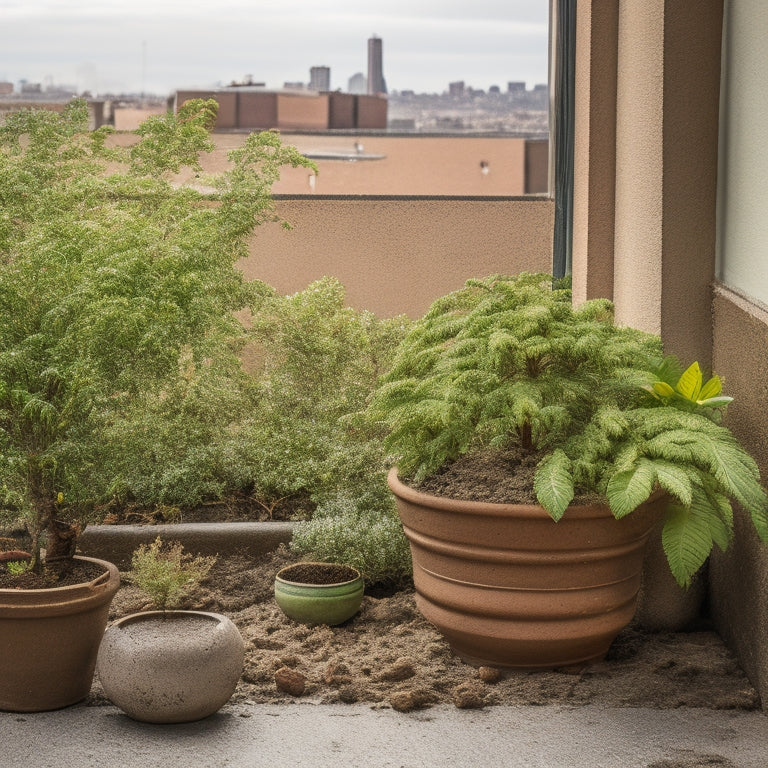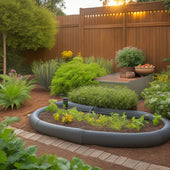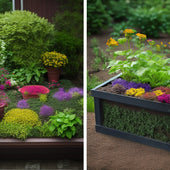
Why Balcony Gardens Fail and How to Fix
Share
You've invested time and effort into creating a beautiful balcony garden, but it's not thriving due to common pitfalls. Limited space and light can hinder growth, but selecting low-light plants and utilizing vertical gardening techniques can help. Wind and weather damage can be mitigated with windbreaks and weather-resistant planters. Soil and water issues, such as waterlogging, can be prevented with well-draining potting mixes and regular moisture checks. Pests and diseases can be addressed with regular monitoring and targeted treatments. Finally, maintenance and neglect can be avoided by establishing a watering schedule and fertilizing regularly. By addressing these common issues, you can transform your struggling balcony garden into a thriving oasis, and there's more to explore to guarantee its success.
Key Takeaways
• Balcony gardens often fail due to inadequate plant selection, neglecting to choose plants tolerant of low-light conditions and local climate.
• Poor vertical gardening techniques, such as inadequate trellises or wall-mounted planters, can lead to wasted space and reduced growth.
• Wind and weather damage can be mitigated by implementing windbreaks, selecting resilient plants, and using weather-resistant planters and mulch.
• Soil and water issues, including waterlogging and root rot, can be prevented by using well-draining potting mixes and monitoring soil moisture regularly.
• Regular maintenance, including pruning, fertilizing, and pest inspections, is crucial to preventing garden decline and promoting healthy growth.
Limited Space and Light
When designing a balcony garden, you often face the intimidating challenge of working with limited space and light, which can severely restrict the types of plants you can grow and the overall aesthetic you can achieve.
To overcome this, it's crucial to focus on plant selection that thrives in low-light conditions and can tolerate compact spaces. Consider plants like ferns, peace lilies, and Chinese Evergreen that can flourish in shaded areas.
For vertical gardening, use trellises or wall-mounted planters to maximize space and create a visually appealing display. Make the most of your balcony's vertical real estate by incorporating tiered planters or hanging baskets. This won't only add depth but also create an illusion of more space.
By choosing the right plants and utilizing vertical gardening techniques, you can create a lush and inviting balcony garden despite the limitations.
With careful planning and execution, you can turn your small balcony into a serene oasis that provides a peaceful retreat from the hustle and bustle of city life.
Wind and Weather Damage
As you've carefully selected plants and optimized your balcony's vertical space, you're now ready to tackle the next challenge: protecting your garden from the harsh realities of wind and weather damage.
Wind can be particularly devastating, as it can dislodge plants, damage leaves, and disrupt soil. To combat this, consider implementing wind protection measures such as windbreaks, trellises, or screens. These can help block gusts and reduce evapotranspiration, allowing your plants to thrive.
In addition to wind, weather resilience is essential for balcony gardens. Extreme temperatures, precipitation, and humidity fluctuations can all take a toll on your plants. To enhance weather resilience, choose plants that are tolerant of local climate conditions.
You can also use weather-resistant planters, mulch, and other materials to help regulate soil temperature and moisture. Finally, be prepared to adapt to changing weather conditions by adjusting your watering schedule and providing supplemental support as needed.
Soil and Water Issues
Two key factors that can make or break your balcony garden are the soil and water conditions, which require careful consideration to prevent common issues like poor drainage, nutrient deficiencies, and root rot.
You need to guarantee that your soil has good drainage to prevent waterlogged soil, which can lead to root rot. At the same time, you want to retain enough water to support healthy plant growth.
Here are some essential tips to get it right:
-
Choose a well-draining potting mix: Avoid using regular garden soil, as it can compact and prevent drainage. Instead, opt for a mix specifically designed for containers.
-
Add organic matter: Incorporate compost, peat moss, or perlite to improve soil structure and water retention.
-
Use pots with good drainage holes: Make sure your pots have holes in the bottom to allow excess water to escape.
- Monitor watering: Check the soil moisture regularly, and avoid overwatering, which can lead to root rot.
Pests and Disease Problems
Contending with pests and diseases is an inevitable challenge in balcony gardening, and failing to address these issues promptly can lead to devastating consequences for your plants.
You must be proactive in monitoring your plants regularly for signs of infestation or infection. Accurate pest identification is essential, as different pests require specific treatments. Inspect your plants carefully, looking for signs like holes in leaves, white powdery residue, or actual pests on the leaves. Once you've identified the pest, you can take targeted action to eliminate it.
Disease prevention is also key. Guarantee good air circulation around your plants by providing sufficient spacing and pruning nearby plants. Remove any infected plants or plant parts to prevent the disease from spreading. Keeping your plants healthy through proper nutrition and watering practices also helps them resist disease.
Maintenance and Neglect
You must commit to a regular maintenance schedule to prevent neglect from creeping into your balcony garden, where forgotten watering, pruning, and fertilizing can quickly turn a thriving space into a barren wasteland.
When you neglect your balcony garden, even the hardiest plants will suffer, and your once-thriving oasis will wither away.
To avoid this fate, make sure to:
-
Water wisely: Don't overwater or underwater your plants. Check the soil moisture daily, and adjust your watering schedule accordingly.
-
Prune regularly: Prune your plants to maintain their shape, promote healthy growth, and encourage blooming.
-
Fertilize frequently: Feed your plants with a balanced fertilizer to provide essential nutrients for growth and development.
- Monitor for pests: Regularly inspect your plants for signs of pests, and take action promptly to prevent infestations.
Frequently Asked Questions
Can I Use Artificial Turf in My Balcony Garden?
You can use artificial turf in your balcony garden, enjoying benefits like low water consumption and uniform appearance. However, remember to follow turf maintenance tips, such as regular cleaning and brushing, to extend its lifespan.
How Often Should I Fertilize My Balcony Plants?
While artificial turf won't nourish your plants, you're on the right track thinking about fertilizer; now, determine the best fertilizer type for your balcony plants and apply it at the ideal nutrient timing, typically every 1-2 weeks during the growing season.
Can I Grow Vegetables in My Balcony Garden?
You can successfully grow balcony vegetables through container gardening, choosing varieties with compact growth habits and requiring minimal space, such as leafy greens, cherry tomatoes, and herbs, which thrive in shallow containers with proper drainage.
Are Self-Watering Planters Really Effective?
"When you're on a roll with balcony gardening, you'll find self-watering planters really effective, as they reduce watering frequency, ensuring your veggies get just the right amount of moisture, and you can breathe a sigh of relief, knowing your plants are in good hands."
Can I Grow a Balcony Garden in a Shaded Area?
You can grow a thriving balcony garden in a shaded area by selecting plants adapted to low light conditions, such as ferns or impatiens, and optimizing their placement to receive indirect sunlight.
Related Posts
-

Best Tools for Creating Block Planters at Home
When creating a block planter at home, you'll need a range of essential tools to guarantee a safe and successful proj...
-

Best Tools for Creating Block Planters at Home
When creating a block planter at home, you'll need a range of essential tools to guarantee a safe and successful proj...
-

Best Tools for Creating Block Planters at Home
When creating a block planter at home, you'll need a range of essential tools to guarantee a safe and successful proj...
-

Best Tools for Creating Block Planters at Home
When creating a block planter at home, you'll need a range of essential tools to guarantee a safe and successful proj...
-

Best Tools for Creating Block Planters at Home
When creating a block planter at home, you'll need a range of essential tools to guarantee a safe and successful proj...
-

Best Tools for Creating Block Planters at Home
When creating a block planter at home, you'll need a range of essential tools to guarantee a safe and successful proj...
-

Best Tools for Creating Block Planters at Home
When creating a block planter at home, you'll need a range of essential tools to guarantee a safe and successful proj...
-

Best Tools for Creating Block Planters at Home
When creating a block planter at home, you'll need a range of essential tools to guarantee a safe and successful proj...
-

Best Tools for Creating Block Planters at Home
When creating a block planter at home, you'll need a range of essential tools to guarantee a safe and successful proj...
-

Best Tools for Creating Block Planters at Home
When creating a block planter at home, you'll need a range of essential tools to guarantee a safe and successful proj...
-

Best Tools for Creating Block Planters at Home
When creating a block planter at home, you'll need a range of essential tools to guarantee a safe and successful proj...
-

Best Tools for Creating Block Planters at Home
When creating a block planter at home, you'll need a range of essential tools to guarantee a safe and successful proj...
-

Best Tools for Creating Block Planters at Home
When creating a block planter at home, you'll need a range of essential tools to guarantee a safe and successful proj...
-

Best Tools for Creating Block Planters at Home
When creating a block planter at home, you'll need a range of essential tools to guarantee a safe and successful proj...
-

Best Tools for Creating Block Planters at Home
When creating a block planter at home, you'll need a range of essential tools to guarantee a safe and successful proj...
-

Best Tools for Creating Block Planters at Home
When creating a block planter at home, you'll need a range of essential tools to guarantee a safe and successful proj...
-

Best Tools for Creating Block Planters at Home
When creating a block planter at home, you'll need a range of essential tools to guarantee a safe and successful proj...
-

Best Tools for Creating Block Planters at Home
When creating a block planter at home, you'll need a range of essential tools to guarantee a safe and successful proj...
-

Best Tools for Creating Block Planters at Home
When creating a block planter at home, you'll need a range of essential tools to guarantee a safe and successful proj...
-

Best Tools for Creating Block Planters at Home
When creating a block planter at home, you'll need a range of essential tools to guarantee a safe and successful proj...
-

Best Tools for Creating Block Planters at Home
When creating a block planter at home, you'll need a range of essential tools to guarantee a safe and successful proj...
-

Best Tools for Creating Block Planters at Home
When creating a block planter at home, you'll need a range of essential tools to guarantee a safe and successful proj...
-

Best Tools for Creating Block Planters at Home
When creating a block planter at home, you'll need a range of essential tools to guarantee a safe and successful proj...
-

Best Tools for Creating Block Planters at Home
When creating a block planter at home, you'll need a range of essential tools to guarantee a safe and successful proj...
-

Best Tools for Creating Block Planters at Home
When creating a block planter at home, you'll need a range of essential tools to guarantee a safe and successful proj...
-

Best Tools for Creating Block Planters at Home
When creating a block planter at home, you'll need a range of essential tools to guarantee a safe and successful proj...
-

Best Tools for Creating Block Planters at Home
When creating a block planter at home, you'll need a range of essential tools to guarantee a safe and successful proj...
-

Best Tools for Creating Block Planters at Home
When creating a block planter at home, you'll need a range of essential tools to guarantee a safe and successful proj...
-

Best Tools for Creating Block Planters at Home
When creating a block planter at home, you'll need a range of essential tools to guarantee a safe and successful proj...
-

Best Tools for Creating Block Planters at Home
When creating a block planter at home, you'll need a range of essential tools to guarantee a safe and successful proj...
-

Best Tools for Creating Block Planters at Home
When creating a block planter at home, you'll need a range of essential tools to guarantee a safe and successful proj...
-

Best Tools for Creating Block Planters at Home
When creating a block planter at home, you'll need a range of essential tools to guarantee a safe and successful proj...
-

Best Tools for Creating Block Planters at Home
When creating a block planter at home, you'll need a range of essential tools to guarantee a safe and successful proj...
-

Best Tools for Creating Block Planters at Home
When creating a block planter at home, you'll need a range of essential tools to guarantee a safe and successful proj...
-

Best Tools for Creating Block Planters at Home
When creating a block planter at home, you'll need a range of essential tools to guarantee a safe and successful proj...
-

Irrigation Solutions for Raised Bed Planters Made Easy
You can optimize your raised bed planters' irrigation system by understanding the complex interplay between soil type...
-

Irrigation Solutions for Raised Bed Planters Made Easy
You can optimize your raised bed planters' irrigation system by understanding the complex interplay between soil type...
-

Irrigation Solutions for Raised Bed Planters Made Easy
You can optimize your raised bed planters' irrigation system by understanding the complex interplay between soil type...
-

Irrigation Solutions for Raised Bed Planters Made Easy
You can optimize your raised bed planters' irrigation system by understanding the complex interplay between soil type...
-

Irrigation Solutions for Raised Bed Planters Made Easy
You can optimize your raised bed planters' irrigation system by understanding the complex interplay between soil type...
-

Irrigation Solutions for Raised Bed Planters Made Easy
You can optimize your raised bed planters' irrigation system by understanding the complex interplay between soil type...
-

Irrigation Solutions for Raised Bed Planters Made Easy
You can optimize your raised bed planters' irrigation system by understanding the complex interplay between soil type...
-

Irrigation Solutions for Raised Bed Planters Made Easy
You can optimize your raised bed planters' irrigation system by understanding the complex interplay between soil type...
-

Irrigation Solutions for Raised Bed Planters Made Easy
You can optimize your raised bed planters' irrigation system by understanding the complex interplay between soil type...
-

Irrigation Solutions for Raised Bed Planters Made Easy
You can optimize your raised bed planters' irrigation system by understanding the complex interplay between soil type...
-

Irrigation Solutions for Raised Bed Planters Made Easy
You can optimize your raised bed planters' irrigation system by understanding the complex interplay between soil type...
-

Irrigation Solutions for Raised Bed Planters Made Easy
You can optimize your raised bed planters' irrigation system by understanding the complex interplay between soil type...
-

Irrigation Solutions for Raised Bed Planters Made Easy
You can optimize your raised bed planters' irrigation system by understanding the complex interplay between soil type...
-

Irrigation Solutions for Raised Bed Planters Made Easy
You can optimize your raised bed planters' irrigation system by understanding the complex interplay between soil type...
-

Irrigation Solutions for Raised Bed Planters Made Easy
You can optimize your raised bed planters' irrigation system by understanding the complex interplay between soil type...
-

Irrigation Solutions for Raised Bed Planters Made Easy
You can optimize your raised bed planters' irrigation system by understanding the complex interplay between soil type...
-

Irrigation Solutions for Raised Bed Planters Made Easy
You can optimize your raised bed planters' irrigation system by understanding the complex interplay between soil type...
-

Irrigation Solutions for Raised Bed Planters Made Easy
You can optimize your raised bed planters' irrigation system by understanding the complex interplay between soil type...
-

Irrigation Solutions for Raised Bed Planters Made Easy
You can optimize your raised bed planters' irrigation system by understanding the complex interplay between soil type...
-

Irrigation Solutions for Raised Bed Planters Made Easy
You can optimize your raised bed planters' irrigation system by understanding the complex interplay between soil type...
-

Irrigation Solutions for Raised Bed Planters Made Easy
You can optimize your raised bed planters' irrigation system by understanding the complex interplay between soil type...
-

Irrigation Solutions for Raised Bed Planters Made Easy
You can optimize your raised bed planters' irrigation system by understanding the complex interplay between soil type...
-

Irrigation Solutions for Raised Bed Planters Made Easy
You can optimize your raised bed planters' irrigation system by understanding the complex interplay between soil type...
-

Irrigation Solutions for Raised Bed Planters Made Easy
You can optimize your raised bed planters' irrigation system by understanding the complex interplay between soil type...
-

Irrigation Solutions for Raised Bed Planters Made Easy
You can optimize your raised bed planters' irrigation system by understanding the complex interplay between soil type...
-

Irrigation Solutions for Raised Bed Planters Made Easy
You can optimize your raised bed planters' irrigation system by understanding the complex interplay between soil type...
-

Irrigation Solutions for Raised Bed Planters Made Easy
You can optimize your raised bed planters' irrigation system by understanding the complex interplay between soil type...
-

Irrigation Solutions for Raised Bed Planters Made Easy
You can optimize your raised bed planters' irrigation system by understanding the complex interplay between soil type...
-

Soil Selection for Successful Planter Garden Boxes
When selecting soil for your planter garden box, it's important to balance drainage, moisture retention, and nutrient...
-

Soil Selection for Successful Planter Garden Boxes
When selecting soil for your planter garden box, it's important to balance drainage, moisture retention, and nutrient...
-

Soil Selection for Successful Planter Garden Boxes
When selecting soil for your planter garden box, it's important to balance drainage, moisture retention, and nutrient...
-

Soil Selection for Successful Planter Garden Boxes
When selecting soil for your planter garden box, it's important to balance drainage, moisture retention, and nutrient...
-

Soil Selection for Successful Planter Garden Boxes
When selecting soil for your planter garden box, it's important to balance drainage, moisture retention, and nutrient...
-

Soil Selection for Successful Planter Garden Boxes
When selecting soil for your planter garden box, it's important to balance drainage, moisture retention, and nutrient...
-

Soil Selection for Successful Planter Garden Boxes
When selecting soil for your planter garden box, it's important to balance drainage, moisture retention, and nutrient...
-

Soil Selection for Successful Planter Garden Boxes
When selecting soil for your planter garden box, it's important to balance drainage, moisture retention, and nutrient...
-

Soil Selection for Successful Planter Garden Boxes
When selecting soil for your planter garden box, it's important to balance drainage, moisture retention, and nutrient...
-

Soil Selection for Successful Planter Garden Boxes
When selecting soil for your planter garden box, it's important to balance drainage, moisture retention, and nutrient...
-

Soil Selection for Successful Planter Garden Boxes
When selecting soil for your planter garden box, it's important to balance drainage, moisture retention, and nutrient...
-

Soil Selection for Successful Planter Garden Boxes
When selecting soil for your planter garden box, it's important to balance drainage, moisture retention, and nutrient...
-

Soil Selection for Successful Planter Garden Boxes
When selecting soil for your planter garden box, it's important to balance drainage, moisture retention, and nutrient...
-

Soil Selection for Successful Planter Garden Boxes
When selecting soil for your planter garden box, it's important to balance drainage, moisture retention, and nutrient...
-

Soil Selection for Successful Planter Garden Boxes
When selecting soil for your planter garden box, it's important to balance drainage, moisture retention, and nutrient...
-

Soil Selection for Successful Planter Garden Boxes
When selecting soil for your planter garden box, it's important to balance drainage, moisture retention, and nutrient...
-

Soil Selection for Successful Planter Garden Boxes
When selecting soil for your planter garden box, it's important to balance drainage, moisture retention, and nutrient...
-

Soil Selection for Successful Planter Garden Boxes
When selecting soil for your planter garden box, it's important to balance drainage, moisture retention, and nutrient...
-

Soil Selection for Successful Planter Garden Boxes
When selecting soil for your planter garden box, it's important to balance drainage, moisture retention, and nutrient...
-

Soil Selection for Successful Planter Garden Boxes
When selecting soil for your planter garden box, it's important to balance drainage, moisture retention, and nutrient...
-

Soil Selection for Successful Planter Garden Boxes
When selecting soil for your planter garden box, it's important to balance drainage, moisture retention, and nutrient...
-

Soil Selection for Successful Planter Garden Boxes
When selecting soil for your planter garden box, it's important to balance drainage, moisture retention, and nutrient...
-

Soil Selection for Successful Planter Garden Boxes
When selecting soil for your planter garden box, it's important to balance drainage, moisture retention, and nutrient...
-

Soil Selection for Successful Planter Garden Boxes
When selecting soil for your planter garden box, it's important to balance drainage, moisture retention, and nutrient...
-

Soil Selection for Successful Planter Garden Boxes
When selecting soil for your planter garden box, it's important to balance drainage, moisture retention, and nutrient...
-

Soil Selection for Successful Planter Garden Boxes
When selecting soil for your planter garden box, it's important to balance drainage, moisture retention, and nutrient...
-

Soil Selection for Successful Planter Garden Boxes
When selecting soil for your planter garden box, it's important to balance drainage, moisture retention, and nutrient...
-

Soil Selection for Successful Planter Garden Boxes
When selecting soil for your planter garden box, it's important to balance drainage, moisture retention, and nutrient...
-

Soil Selection for Successful Planter Garden Boxes
When selecting soil for your planter garden box, it's important to balance drainage, moisture retention, and nutrient...
-

Soil Selection for Successful Planter Garden Boxes
When selecting soil for your planter garden box, it's important to balance drainage, moisture retention, and nutrient...
-

Soil Selection for Successful Planter Garden Boxes
When selecting soil for your planter garden box, it's important to balance drainage, moisture retention, and nutrient...
-

Soil Selection for Successful Planter Garden Boxes
When selecting soil for your planter garden box, it's important to balance drainage, moisture retention, and nutrient...


